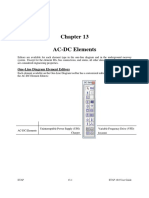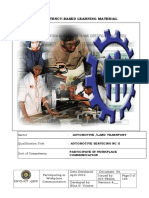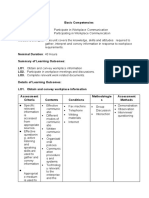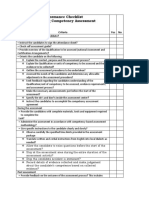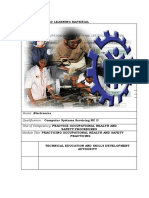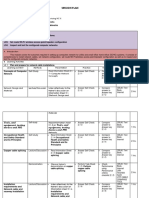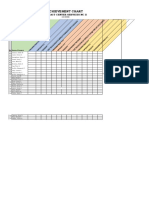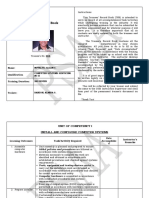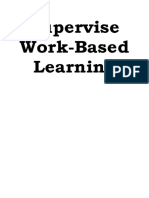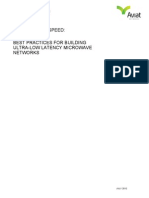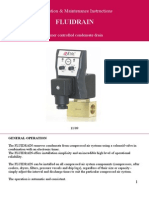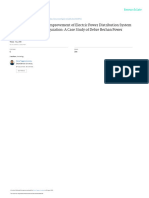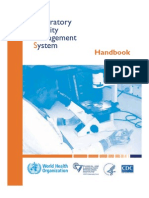Apply Quality Standards Module 1 W1
Uploaded by
Mat Domdom V. SansanoApply Quality Standards Module 1 W1
Uploaded by
Mat Domdom V. SansanoCOMPETENCY-BASED LEARNING MATERIALS
Sector:
ELECTRONICS
Qualification:
ELECTRONIC PRODUCTS ASSEMBLY AND SERVICING NC II
Unit of Competency:
APPLY QUALITY STANDARDS
Module Title:
APPLYING QUALITY STANDARDS
SANAIVHS
Centro San Antonio, City of Ilagan, Isabela
HOW TO USE THIS MODULE
Welcome to the Module “Applying Quality Standards”. This module
contains training materials and activities for you to accomplish.
The unit of competency “Apply Quality Standards”, contains the
knowledge, skills and attitudes required for ELECTRONIC PRODUCTS
ASSEMBLY AND SERVICING NC II.
You are required to go through a series of learning activities in order to
complete each of the learning outcomes of the module. In each learning
outcome there are Information Sheets and Activity Sheets. Follow these
activities on your own and answer the Self-Check at the end of each learning
activity.
If you have questions, don’t hesitate to ask your for assistance.
INTRODUCTION
Program/ Course: Electronic Product Assembly and Servicing
Unit of Competency: Apply Quality Standards
Module: Applying of Quality Standards
INTRODUCTION:
This module contains information and suggested learning activities on
Computer Hardware Servicing. It includes training materials and activities for
you to complete.
Completion of this module will help you better understand the
succeeding module on Computer Hardware Servicing.
This module consists of 3 learning outcomes. Each learning outcome contains
learning activities supported by each instruction sheets. Before you perform the
instructions read the information sheets and answer the self-check and
activities provided to as certain to yourself and your teacher that you have
acquired the knowledge necessary to perform the skill portion of the particular
learning outcome.
Upon completion of this module, report to your teacher for assessment to
check your achievement of knowledge and skills requirement of this module. If
you pass the assessment, you will be given a certificate of completion.
SUMMARY OF LEARNING OUTCOMES:
Upon completion of the module you should be able to:
LO1 Assess Quality of Received Materials or Components
LO2 Assess own work
LO3 Validate one’s work for quality improvement
ASSESSMENT CRITERIA:
Refer to assessment criteria of learning outcomes #1-3 of this module.
TECHNICAL TERMS
Checklist - help organize data by category
Durability - enduring; resisting wear
Flowchart - describes process in as much detail as possible by
graphically displaying the steps in proper sequence
Hardware - refers to the electronic and mechanical components that
make a computer system.
Histogram - plots data in a frequency distribution table
Hostile - being an enemy; unfriendly
ISO - International Standardization Organization
OHS - Occupational Health and Safety procedures
Pareto diagram- puts data in a hierarchical order which allows the
significant problems to be connected first.
PPE - personal protective equipment
Quality - essential character nature; degree or grade of excellence
Scatter diagram- shows how two variables are related and is this used
to test for cause and effect relationships.
Standards -as one serving the emblem of a nation; something as
accepted as a basis for comparison
Upon completion of the module you should be able to:
LO1 Assess Quality of Received Materials and Components
INFORMATION SHEET 1.1-1
Characteristics of Materials Used in Specific Projects
The student must relate material properties to product and process
quality. These are the factors that must be taken into consideration when
choosing the right material for their components and assemblies:
1. Selection of material
Material selection is one of the most common tasks for
design engineering. The ability to assess the material’s
impact on the performance of a product is crucial for reliable
performance. Sometimes, buyers are also considering the
label or name of the company which are producing great
quality of materials and are known in the market. Examples
are the name HP for printer and Intel for some computer
hardware.
2. Testing of material
The testing of material properties is widely understood to
be the key to obtaining data for a project, performing failure
analysis, or understanding material interactions. Material
testing also provides information on the quality of incoming
and outgoing products. Inspection test equipment and techniques are
demonstrated for a wide range of materials and assemblies during the class.
This provides the participants with both knowledge of the common failure
modes.
3. Cost of material
The cost of material is also considered when buying or selecting
materials for a specific project. The amount may vary but never taken for
granted the quality and the reliability of the material. Will you buy material
which is less expensive but worst quality? Will you buy material which you
cannot afford? People look for places which can meet their standards and right
cost for materials to buy.
and planning process. Evaluation of longevity criteria and assessment of site environmental factors are vital to project plan
erial selection. Although many materials can offer enhanced protection, often the most cost-efficient and readily available m
Before planning and designing takes place, you should evaluate the
material options and system requirements. Teachers should add several useful
reference manuals to their libraries such as installation of hardware,
networking, troubleshooting as well as basic PC Operation and Internet for
additional information that the students may use in their projects.
The characteristic of the materials to be used for specific project must be:
of good quality
- This is the most important factor when choosing materials to buy. Products
with good quality are long-lasting and safe to use because you know that it
follows certain standards before being commercialized.
reliable
- It means that you can be sure that it will perform its function well, will
operate safely and will give the best it could give.
suitable for the application/purposes
- Choose the materials which are very necessary to make the project possible.
Making a list of products/materials to buy is a good trait of a wise consumer.
Products which are not to be used must be crossed out.
low cost
- It doesn’t mean that you will choose for the less expensive
one and exclude the quality. Low cost means you can afford to
buy the materials without hurting your pocket and assure of
better quality.
SELF-CHECK 1.1-1
I. Enumerate the following. Use a separate sheet of paper in answering.
1. Give three factors to be considered when choosing the right material?
______________________________________________
______________________________________________
______________________________________________
2. Give three characteristic of materials to be used for specific project?
______________________________________________
______________________________________________
______________________________________________
II. What Good Quality means?
______________________________________________
______________________________________________
______________________________________________
INFORMATION SHEET 1.1-2
FAULT IDENTIFICATION AND REPORTING
These are the things to be considered when:
A. Receiving Materials:
1. Match the packing slip to the items received and ensures that the
materials are destined on tour department.
2. That you are receiving the materials indicated on the purchase order
with regard to quantity and discount.
3. That the materials are in acceptable condition.
4. Thatterm regarding installation and/or set-up of equipment are met.
B. Receiving Reports
Whenever goods are received:
1. The person receiving the goods must document, using
the administrative software, that all goods were
received for each requisition before any payment can
be made to the vendor.
2. Any exceptions must be noted so that partial payments
can be processed or defective goods can be returned.
C. Return of Merchandise
When merchandise is received which is incomplete or defective, the supervisor
will return the materials to the supplier or to the store where it was bought and
make arrangements with the vendor for replacement.
D. Make an Inventory Report of the Materials
All materials received must be listed and be reported to monitor how
many materials are already on hand, purchased or damaged.
Effective management checks are an important means of providing
assurance of the integrity and security of the benefit processes. They are also
useful in identifying training needs; indicating possible weaknesses in
procedure and ensuring the section meets its accuracy target set for Best Value
Performance Indicators purposes.
Methodology
The teacher will be the assessor. Students will be randomly assigned that
will: 1.) act as Quality Checker; 2.) responsible for monitoring and coordinating
the checking arrangements and; 3.) must generate reports when receiving the
equipments.
The Quality checker will record the date of receipt, name of the materials
purchased, quantity, official receipt number, signature of the person who
bought the materials and signed his name afterwards. The Quality checker will
identify if the materials are in good condition or damage and /or needing for
replacements. This will also be recorded on his report.
Feedback
Once the Quality checker has completed all the reports, the assessor will
check if the Quality Checker provides all the data needed in the report.
Example of Log Report (to be completed by the Quality checker)
Date O.R. # Item Quantity Signature Quality
Received Name Checker
Example of Assessment of Materials Received (to be completed by the Quality
checker)
Quality Checker: Date:
Item Name Total no. in Total No. of Comment
Good Errors
Condition
ACTIVITY SHEET 1.1.1
You are assigned to be the Quality checker for the Month of June. Make
a Log Report, and Assessment Report using the following data below. Make sure
you will record all the items listed and if they were in good condition or not.
Write your answer on a sheet of paper.
1. - June 9, 2008
- 5 Hard disk, 2 128MB SDRAM memory chips
- Received from Jun Salcedo (PC chain), OR #20256
- Found out that 1 Hard disk has error need for replacement
2. - June 15, 2008
- Refill ink cartridge from STARINK Shop, OR# 5623
3. - June 20, 2008
- 10 PS/2 keyboard, 10 Optic mouse, 2 power supply
- Received from Allan Rivera (Octagon), OR#12544
- 3 defective keyboard need replacement
4. - June 28, 2008
- 2 CD-Rom drive
- Received from Jun Salcedo (PC Chain), OR#20400
ASSIGNMENT
1. What is workplace procedure?
2. Give five examples of behavior that may affect the quantity of work.
3. Give five examples of behavior that may affect the quality of work.
Reference:
www.yahoo.com
www.wikipedia.com
You might also like
- School Base Training Facilities: Layout Prepare Trial BalanceNo ratings yetSchool Base Training Facilities: Layout Prepare Trial Balance6 pages
- Introducing SIRE 2.0 Industry Associations Awareness Session - 6 May100% (3)Introducing SIRE 2.0 Industry Associations Awareness Session - 6 May21 pages
- Evidence Plan: Machining NCII Turn Work Piece (Intermediate)100% (1)Evidence Plan: Machining NCII Turn Work Piece (Intermediate)12 pages
- CHS CBLM - Apply Quality Standards - FINALNo ratings yetCHS CBLM - Apply Quality Standards - FINAL51 pages
- Observe Procedures Specifications and Manuals of InstructionNo ratings yetObserve Procedures Specifications and Manuals of Instruction39 pages
- CBLM Common Apply Quality Standards 1 (Revised)100% (1)CBLM Common Apply Quality Standards 1 (Revised)32 pages
- Performance Checklist Conducting Competency Assessment: Criteria Yes NoNo ratings yetPerformance Checklist Conducting Competency Assessment: Criteria Yes No5 pages
- Grade 8 Perform Mensuration CBLM SLM LASNo ratings yetGrade 8 Perform Mensuration CBLM SLM LAS62 pages
- Session Plan: Health, Social and Other Community Development Services Bookkeeping NC IiiNo ratings yetSession Plan: Health, Social and Other Community Development Services Bookkeeping NC Iii4 pages
- Cblm-Occupational Health and Safety ProceduresNo ratings yetCblm-Occupational Health and Safety Procedures64 pages
- Philippine Electronics and Communication Institute of Technology100% (1)Philippine Electronics and Communication Institute of Technology1 page
- SESSION PLAN Sector Electronics Sector QNo ratings yetSESSION PLAN Sector Electronics Sector Q6 pages
- CBLM 107 Practicing Career Professionalism100% (1)CBLM 107 Practicing Career Professionalism92 pages
- Facilitating Training Facilities-OrientationNo ratings yetFacilitating Training Facilities-Orientation33 pages
- Achievement Chart: Contact Center Services NC Ii0% (1)Achievement Chart: Contact Center Services NC Ii3 pages
- 21st Century Skills Module 1 - Basic Participate Workplace Communication Session PlanNo ratings yet21st Century Skills Module 1 - Basic Participate Workplace Communication Session Plan27 pages
- CBLM-Participate in Workplace CommunicationNo ratings yetCBLM-Participate in Workplace Communication163 pages
- Practice Entrepreneurial Skills in The WorkplaceNo ratings yetPractice Entrepreneurial Skills in The Workplace38 pages
- Competency-Based Curriculum: Sector: Qualification: Contact Center Services NC Level: NC IINo ratings yetCompetency-Based Curriculum: Sector: Qualification: Contact Center Services NC Level: NC II11 pages
- Technology Plan and Infrastructure Support System Journalize Transactions "Prepare Chart of Accounts" A. Technology Plan I. Course DesignNo ratings yetTechnology Plan and Infrastructure Support System Journalize Transactions "Prepare Chart of Accounts" A. Technology Plan I. Course Design4 pages
- 5 Yoyoy 2 - CBLM Common Using Hand ToolsfinalNo ratings yet5 Yoyoy 2 - CBLM Common Using Hand Toolsfinal35 pages
- Computer (M1Q1) - APPLYING QUALITY STANDARDS (AQS)No ratings yetComputer (M1Q1) - APPLYING QUALITY STANDARDS (AQS)8 pages
- Bookmark Not Defined.: API RP 584 Integrity Operating Windows100% (2)Bookmark Not Defined.: API RP 584 Integrity Operating Windows36 pages
- Fluidrain: Installation & Maintenance InstructionsNo ratings yetFluidrain: Installation & Maintenance Instructions12 pages
- Generator Circuit Breaker Brochure Retrofit Application Brochure GB - FR-FR100% (1)Generator Circuit Breaker Brochure Retrofit Application Brochure GB - FR-FR8 pages
- WHO Laboratory Quality Management System Handbook100% (5)WHO Laboratory Quality Management System Handbook247 pages
- Precision Unleashed Mastering Data Quality For Unrivaled Analytics ExcellenceNo ratings yetPrecision Unleashed Mastering Data Quality For Unrivaled Analytics Excellence3 pages
- Mastering Your Construction Budget The Ultimate Guide To Building Estimating Services 673d6bfeNo ratings yetMastering Your Construction Budget The Ultimate Guide To Building Estimating Services 673d6bfe14 pages
- Jurmatis: Perancangan Penjadwalan Perawatan Mesin Bubut Dengan Metode SMK Negeri 1 KediriNo ratings yetJurmatis: Perancangan Penjadwalan Perawatan Mesin Bubut Dengan Metode SMK Negeri 1 Kediri11 pages
- IC Basic Stakeholder Engagement Plan Template Example WORDNo ratings yetIC Basic Stakeholder Engagement Plan Template Example WORD4 pages
- ADA-Project-Scientist-Notification-2025-1No ratings yetADA-Project-Scientist-Notification-2025-19 pages
- Trimble 450l and 450H Radios: Key FeaturesNo ratings yetTrimble 450l and 450H Radios: Key Features2 pages
- Mechatronic Developments For Railway Vehicles of The FutureNo ratings yetMechatronic Developments For Railway Vehicles of The Future12 pages





